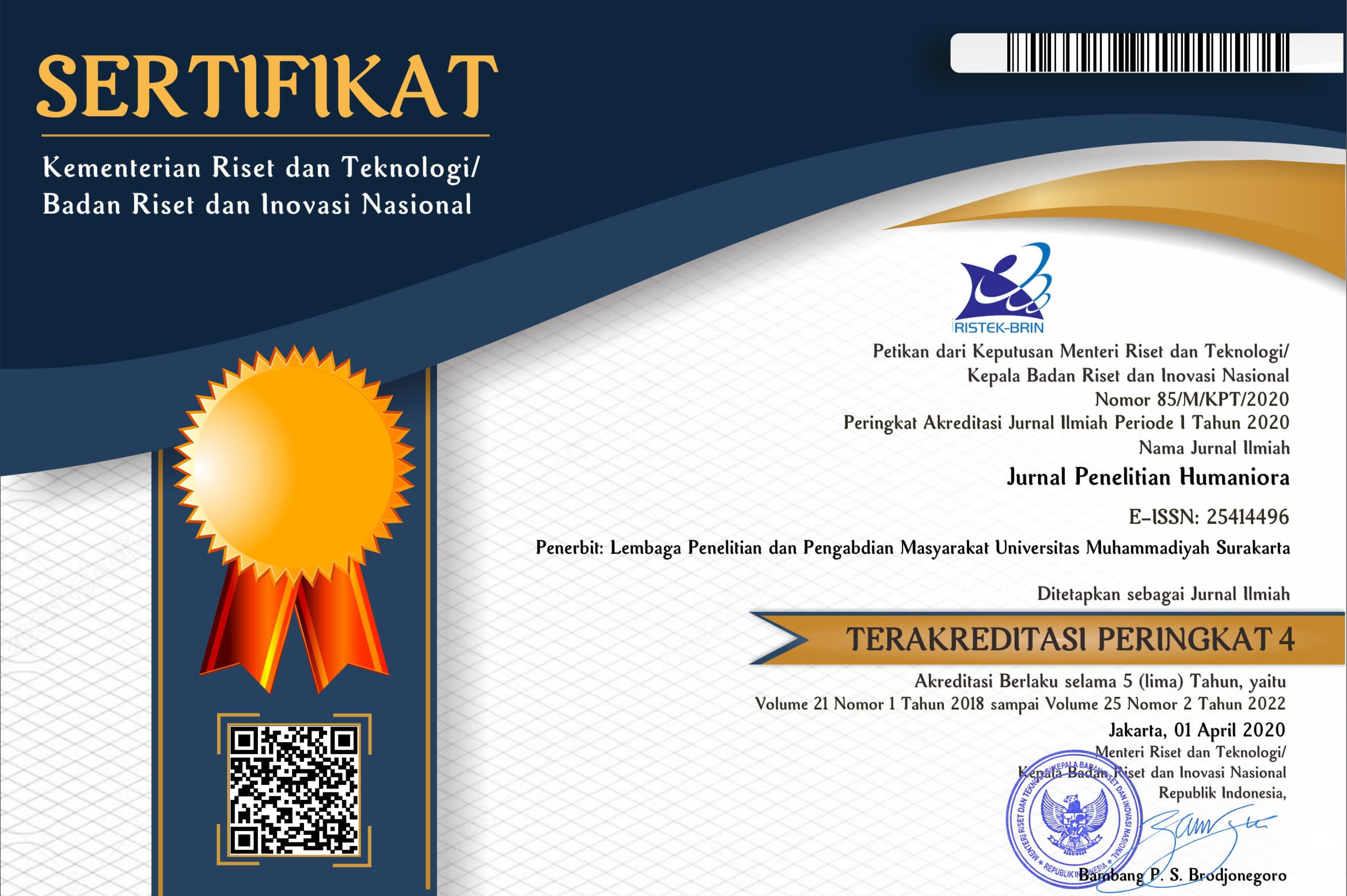SPEECH ERRORS IN A TALK SHOW PROGRAM OF METRO TV FACE TO FACE WITH DESI ANWAR BROADCASTED IN JANUARY TO JUNE 2012
Farida Indri Wijayanti(1*)(1) AIAN Surakarta
(*) Corresponding Author
Abstract
This article explores the types of speech errors, the frequency of each type of speech error, the dominant of speech error, and the sources of speech errors in the talk show program of Metro TV Face to Face with Desi Anwar broadcasted in January to June 2012. Descriptive and library research are applied as method. The data are utterances containing speech errors produced by guest speakers. The method of collecting data is documentation. Investigator triangulation is used by cross checking the findings or the interpretation of data with expert judgment in order to strengthen the validity. The technique for analyzing data is error analysis. The results show that there are 253 utterances containing 428 speech errors which are derived from 9 types of speech errors based on Clark and Eve, Gleason and Ratner, and Poulisse theory. The distribution of each type of error is started by 143 filled pauses (33.41%). The number of speech errors comprises of 121 repeats (29.88%), 49 slips of the tongue (12.10%), 39 retraced false starts (9.63%), 18 corrections (4.44%), 18 unretraced false starts (4.44%), 17 interjections (4.20%), 12 silent pauses (2.96%), and 11 stutters (2.72%). From the frequency of the speech errors, it can be drawn that the most dominant error is filled pause. The speech errors are mostly caused by three sources; they are cognitive difficulty, situ- ational anxiety, and social reasons.
Keywords
Full Text:
PDFReferences
Akmajian et al. 2010. Linguistics: an Introduction to Language and Communication. London: The MIT Press.
Clark, Herbert. H and Eve V. Clark. 1977. Psychology and Language: An Introduction to Psycholinguistics. New York: Harcourt Brace Jovanovich. Inc.
Cowles, Wind.H. 2011. Psycholinguistics 101. New York. Springer Publishing Company, LLC.
Ellis, Rod. 1997. Second Language Acquisition. Oxford: Oxford University Press
Frisch, A Stefan and Wright, Richard. 2002. “The Phonetics of Phonological Speech Errors: An Acoustic Analysis of Slips of the Tongue”. In Journal of Phonetics (2002) 30, 139–162
George, W. Marry. 2008. The Elements of Library Research: What Every Student Needs to Know. New Jersey: Princeton University Press
Gleason, B. Jean and Ratner B. Nan. 1998. Psycholinguistics. Florida: Harcourt Brace College Publisher
Guion, A. Lisa. 2002. Triangulation: Establishing the Validity of Qualitative Studies1. Florida: University of Florida, Gainesville
Hardini, Fitria. 2010. Speech Errors Made by Mike Lowrey and Marcus Burnett in “Bad.Boys I” (the Movie). Unpublished.
Hasnun, Nisa. 2009. A Study on Speech Errors Made by Global TV VJ The Music Programs: Most Wanted. Unpublished.
Kuiper, Koenraad. and Allan. W. Scott. 2004. An Introduction to English Language Word, Sound, Sentence: Second Edition. New York: Palgrave Macmillan
Kovaè, Mirjana M. 2011. “Speech Errors in English as Foreign Language: ACase Study of Engineering Students in Croatia”. In English Language and Literature Studies, Vol. 1, No. 1, June 2011.
Lumbantobing, C H Ivan. “Speech Errors in Interviews of Metro TV’s Indonesia This Morning News Program”. Unpublished.
Marshall, Jane. 2006. “Jargon aphasia: What have we learned”? Aphasiology 20. 387-- 410.
Nawawi, Handari dan Martini, Mimi. 2005. Penelitian Terapan. Yogyakarta: Gadjah Mada University Press
Paulisse. Nanda. 1999. Slips of the Tongue: Speech Errors in First and Second LanguageProduction. Amsterdam and Philadelphia: John Benjamins
Rodgers et al. 2010. “Voice and Fluency Changes as a Function of Speech Task and Deep Brain Stimulation.” In Journal of Speech, Language, and Hearing Research (2010) Vol. 53,
–1177 http://youtube.com
Article Metrics
Abstract view(s): 2353 time(s)PDF: 1325 time(s)
Refbacks
- There are currently no refbacks.











